

 Turning a Basic Bowl: Two-Evening Workshop with Frank Bowers
Turning a Basic Bowl: Two-Evening Workshop with Frank Bowers
Tuesday & Wednesday
April 18 & 19
9am-5pm
Class Size: 8
Tuition: $95
Item# 991363
 Beyond the Square: Adding Curves to Your Furniture with Seth Rolland
Beyond the Square: Adding Curves to Your Furniture with Seth Rolland
Saturday & Sunday
April 29 & 30
9am-5pm
Class Size: 10
Tuition: $325
Item# 991369
Download a printable version of our Spring Class Schedule
 Spring Cleaning
Spring Cleaning
About this time every year it seems we all get a hankering to clean something, get started again on the project we put away last fall, or maybe you're moving to
a new house. Often when furniture has been stored in the garage, out building or storage unit, it may be covered in mold and mildew or it simply appears as though it could use a good cleaning.
Here are a few tips to help you along in your annual Spring Cleaning.
Read Alan's Tips
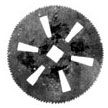
Although the first patent for a circular saw was granted to Samuel Miller of England in 1777, the invention of the first circular saw used in a sawmill is ascribed to Shaker Sister Tabitha Babbitt. Babbitt was working in the spinning house at the Harvard Shaker community in Massachusetts in 1813, when she envisioned an improvement to the two-man pit saws that were being used for lumber production. In
Gleanings From Old Shaker Journals
, Sarah Endicott Sears gives the following description:
"One of the most talented women among the Shakers was Tabitha Babbitt. One day as she was spinning, she noticed the brethren sawing wood the old-fashioned way; she observed that one half of the motion was lost, and so conceived the idea of the circular saw.
She made a thin disk, notched it around the edge, slipped it on the spindle of her spinning wheel, tried it on a piece of shingle, found that it would cut and gave the world the buzz saw."
The first circular saw made under Babbitts instructions is on exhibit in the Geological Building at Albany, New York. She is also credited with inventing a new method of making false teeth, an improved spinning wheel head, and an improved version of cut (as opposed to individually-forged) nails, which later enabled the mass production of nails.
However, the Shakers did not believe in patents, feeling that patent money savored of monopoly and violated the Golden Rule; therefore, Babbitt did not obtain any patents for her inventions.
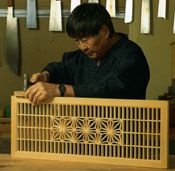
Toshio Odate was born in Japan in 1930 and during the immediate post-war years served an apprenticeship as a maker of sliding doors. He went on to study art and design, and in 1958 was awarded a fellowship for the introduction of traditional Japanese woodworking in the United States, where he has remained.
Over the following four decades, Odate taught industrial design and sculpture at the university level, exhibited his own sculptures, and demonstrated Japanese woodworking techniques and attitudes at many workshops, classes and seminars throughout the U.S. and Europe. He has written articles for
Fine Woodworking
,
American Woodworker
,
Woodwork
and
Woodshop News
magazines, and is the author of
Japanese Woodworking Tools: Their Tradition, Spirit and Use
and
Making Shoji
. Odate has also been featured in several videos and televison productions, including
Martha Stewart Living
and the
Woodwright's Shop
. He currently resides in Woodbury, Connecticut.
Highland Hardware is delighted to welcome back woodworking legend Toshio Odate on May 20 & 21 to conduct a 2-day seminar,
Japanese Woodworking Tools and Traditions
(991395). Odate's Saturday class will cover the spectrum of Japanese tools for woodworking, and especially focus on recent developments in sharpening equipment and techniques in which he has been an active participant. On Sunday Odate will construct a shoji, or Japanese screen, using Japanese hand tools and techniques, right down to the shop-made rice glue fastening the rice paper to the wooden frame! This will be an informative and busy weekend with a superb teacher who has done as much as anyone to make Japanese tools accessible and useful for a generation of American woodworkers.
Odates visit includes a slideshow and lecture,
Toshio Odate, the Sculptor
(991394), at 7pm on Friday, May 19. The lecture and slideshow will introduce us to Odate's successful career as a sculptor and art professor, an aspect of his work the woodworking world hasn't seen. The lecture is included at no additional charge for those enrolled in his weekend class, but is open to anyone for $25.
See a detailed description and/or register for Toshio's lecture/slideshow on May 19,
Toshio Odate, the Sculptor
(991394)
See a detailed description and/or register for Toshio's class on May 20 & 21,
Japanese Woodworking Tools and Traditions
(991395)
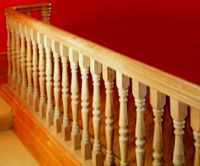
E-mail us at
woodnews@highlandhardware.com
with your woodworking or finishing questions. Selected
questions will be answered in future issues. If your
question is selected for publication, we'll send you a
free Highland Hardware hat.
Question:
I am a neophyte and need some guidance. I am in the process of stripping
off multiple layers of paint from a 100-year-old balustrade that has
about 40 balusters made of a light-colored, beautifully grained hardwood
species unknown (to me at least). I am trying to decide about a new
finish.
Finishes are applied to wood for protection, dimensional stability and beauty, right? It seems to me that this wood doesn't need too much protection perhaps the greatest risk is of scuffmarks from a stray foot now and then. As to dimensional stability, a baluster does not have the same requirements for stability that wooden furniture has. And beauty? Well, I don't know that applying a finish will enhance its natural beauty; I like the way it is.
So I think, why finish it? But then I have a nagging feeling that I
ought to apply at least
some
sort of finish. I read about tung oil and
considered using it, but then read that penetrating oils highlight surface defects and what with the 100 years of use (those stray feet, etc.), and the gouges from stripping the paint (I am an amateur at this), there are surface defects that just can't be removed. I have thought about water-based finishes if possible, I would like to use a water-based finish and went to several local paint stores and my local big-box store, none of which have much of a selection of water-based finishes.
So, another thought I had was to just put a coat of wax on the wood. But the question then becomes what kind of wax?
Answer
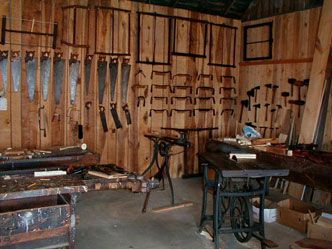
Wade Whitlock, a volunteer at Steppingstone Museum's Woodworking Shop with responsibilities including artifact cataloging, display, demonstration and teaching, contributed the following article detailing the museum and its collections. He also provided wonderful photographs of Steppingstone, enabling readers to take a
virtual tour
of the museum and farm!
He writes:
"I began woodworking in the late 1970's, inspired by having just bought a house and watching Roy Underhill's Woodwright Shop show. Somehow I began volunteering at Steppingstone Museum in the early 1990's and began studying the traditional tools and methods, as well as learning a bit of blacksmithing. I take trips to Williamsburg whenever I can to learn from the experts there. As a Certified Industrial Hygienist I appreciate the lack of noise, dust and (mostly) the absence of whirling blades with traditional methods."
Steppingstone Museum
Havre de Grace, Maryland
By Wade Whitlock
In the early 1960's J. Edmund Bull converted his tool collection into a museum at his home that he named Steppingstone. The collection was begun perhaps 20 years before around his grandfather's tools. A group of like-minded people began to help demonstrate, describe and even collect, and became known as the Steppingstone Association. In 1968, Steppingstone Museum Trust of Harford County, Maryland, Incorporated (a real mouthful) received the entire Ed Bull collection. At that time, there were about 7,000 artifacts and there have been well over 5,000 donations since. The Museum was moved to its present location in 1978 after Mr. Bull's death.

We invite you to participate in the Highland Hardware Turning Contest, featuring our new 4-in-1 Screwdriver Kits (161960). The contest rules and guidelines are as follows:
Highland Hardware Turning Contest Online Entry Form
Highland Hardware Turning Contest Entry Form (Print Version to Mail In)
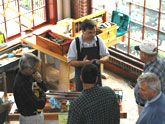
Come spend the day at Highland Hardware for our Spring Tool Sale! We'll have free woodworking demonstrations throughout the day, free refreshments, door prizes and special in-store pricing on hundreds of items.
The shops and eateries here in Virginia-Highlands will keep your family fed and busy all day, so bring the whole clan and come on down!
Due to customers' concerns about lack of parking, we've decided not to have a tent, so there will be plenty of space in our lot.

The Georgia Association of
Woodturners (GAW) is dedicated to providing
education, information and organization to those
interested in woodturning. GAW services those in the
metro-Atlanta area.
We meet on the third Thursday of
each month at 7pm at Highland Hardware. Meetings are
open to all.
Enter through the loading dock at the
rear of the building and go upstairs. Remember, Highland
Hardware closes at 6pm, so come early to shop!
www.gawoodturner.com

If
you
do not
currently receive our catalog and would
like to do so, please contact our
Catalog Request Department
,
or you may call our
24-Hour Toll-Free
CATALOG REQUEST LINE:
(888) 500-4466